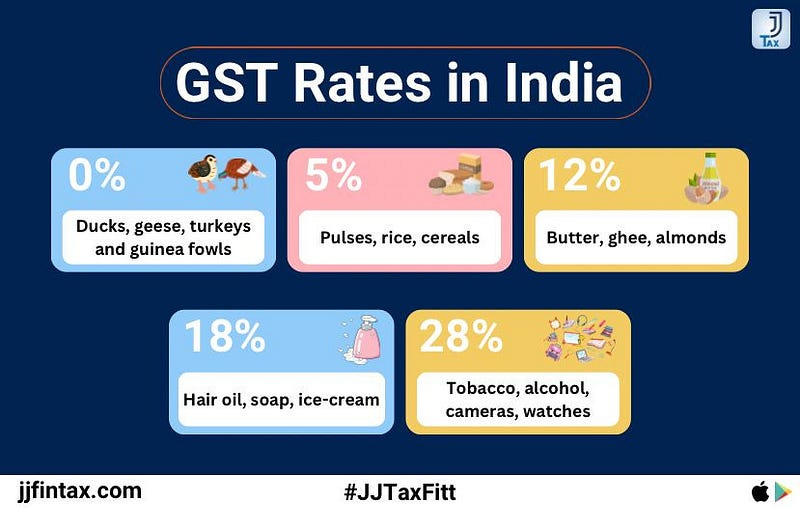From consumer's prospective

Did you know?
The Indian government just collected a whopping ₹1,68,337 crore in GST revenue for February 2024 — that’s a 12.5% jump compared to last year!
This growth was driven by a 13.9% rise in GST from domestic transactions and an 8.5% increase in GST from import of goods. This surge suggests a booming economy, but what does it mean for you, the consumer? A healthy GST collection, like the one we just saw, indicates a thriving market with increased consumer spending. However, understanding how GST works can significantly impact your spending habits and financial decisions.
While you might feel that understanding the intricacies of GST might not be your cup of tea (pun intended!), knowing the basics helps you make smarter financial decisions. That is precisely our intention with this JJ Tax newsletter.
GST Rate
The GST regime simplifies taxation by categorizing goods and services into primary rates: 0%, 5%, 12%, 18%, and 28%. Items with 0% Goods and Services Tax Rate are Live poultry, that is to say, fowls of the species Gallus domestic us, ducks, geese, turkeys and guinea fowls. Meat of bovine animals, fresh and chilled. All goods (other than fresh and chilled) other than pre-packaged and labelled. Essential commodities like staple foods and life-saving medicines are taxed at the lowest 5% slab, ensuring that necessities remain affordable. On the other hand, luxury and sin goods, such as high-end cars, tobacco products, and aerated beverages, attract the highest 28% rate. By familiarizing yourself with these rate categories, you can make more informed purchasing decisions and budget accordingly, aligning your spending with your financial goals.
GST on Pre-Packaged and Labelled Essentials
In a move aimed at streamlining the taxation system further, the GST council, in its 47th meeting held in June 2022, recommended a 5% GST levy on certain essential items like pulses, rice, cereals, etc., when supplied as “pre-packaged and labelled” products. These changes came into effect on 18th July 2022.
Previously, these staple items were taxable only if they were supplied under a brand name and packed in a unit container. This decision by the GST council brings more transparency and uniformity in the taxation of essential commodities, ensuring that consumers are aware of the applicable tax rates regardless of the packaging or branding. As a responsible consumer, staying updated on such policy changes is crucial to make well-informed purchasing decisions and manage your household budget effectively.
The levy of 5% GST on pre-packaged and labelled essential items like cereals, pulses and flour has sparked a debate, with critics arguing that it will lead to a rise in prices, impacting the typical consumer’s household budget. This viewpoint is significant in the current economic climate of rising fuel prices and daily consumables. Some state governments have also opposed the move and expressed their intention not to levy GST on these essential commodities.
However, the central government and the GST council have clarified that these changes are aimed at plugging revenue leakages and preventing the misuse of exemption provisions by unregistered businesses. They have stated that there is no substantial change in the GST coverage, except for a couple of items, as most of the goods in question are already being sold under brand names with GST levied. The rationale is to create a level playing field for all suppliers and ensure tax compliance.
GST on Luxury Items
Luxury items are those goods or services that are considered to provide comfort, enjoyment, or pleasure to a person’s life, but are not essential for survival or well-being. Under the Goods and Services Tax (GST) regime in India, luxury items are taxed at the highest rate of 28%, along with sin goods such as tobacco, alcohol, and aerated drinks. Some examples of luxury items that fall under this tax bracket are cars, motorcycles, air conditioners, refrigerators, washing machines, televisions, cameras, watches, perfumes, cosmetics, and jewellery. The government has decided to continue this tax rate on luxury and sin goods to generate revenue and discourage their consumption.
Breaking Down the Jargon
We have all received a bill with a string of seemingly cryptic codes and wondered what they mean. Let’s break down the jargon first
CGST (Central Goods and Services Tax): This tax goes to the central government and applies to intra-state transactions (within the same state).
SGST (State Goods and Services Tax): This tax goes to the state government and also applies to intra-state transactions.
IGST (Integrated Goods and Services Tax): This tax applies to inter-state transactions (across different states).
The rate and amount of CGST, SGST, and IGST depend on the nature and value of the supply, the place of supply, and the GST rate applicable to the goods or services. Generally, CGST and SGST are levied at equal rates for intra-state supplies, while IGST is levied at the sum of CGST and SGST rates for inter-state supplies.
At JJ Tax, we understand the complexities surrounding GST and its impact on individual finances. As your trusted tax advisors, we are here to address any queries or concerns you may have regarding GST and its implications for your household budget.
Stay compliant, stay informed, and stay ahead — with JJ Tax by your side.

